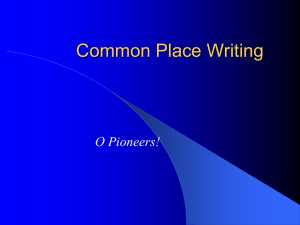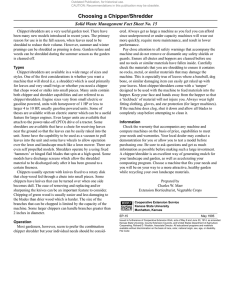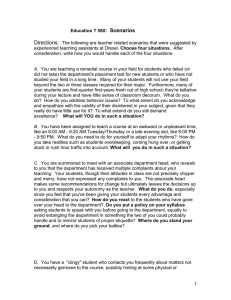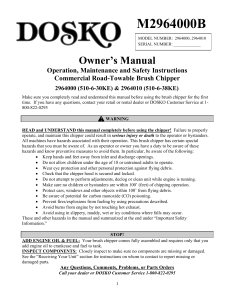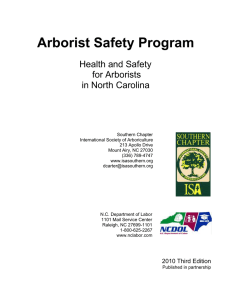MICHIGAN EASTERN U N I V E R S I T Y
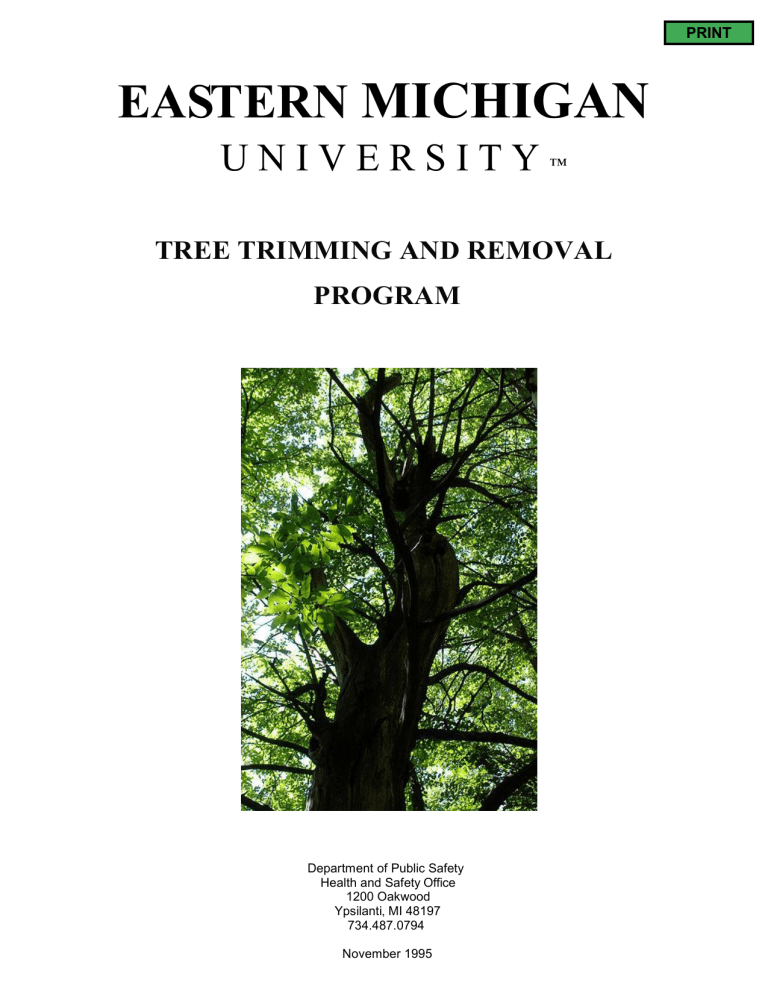
EASTERN MICHIGAN
U N I V E R S I T Y
™
TREE TRIMMING AND REMOVAL
PROGRAM
Department of Public Safety
Health and Safety Office
1200 Oakwood
Ypsilanti, MI 48197
734.487.0794
November 1995
ITEM
EASTERN MICHIGAN UNIVERSITY
HAZARD COMMUNICATION PROGRAM
TABLE OF CONTENTS
PAGE
3
3
3
2
2
2
2
1
1
1
2
6
6
5
5
6
6
3
4
4
3
3
5
PURPOSE
Eastern Michigan University’s Tree Trimming and Removal Program has been written to achieve compliance with the Michigan Department of Labor Part 53
Tree Trimming and Removal Standard. This standard provides minimum requirements for tools and equipment, their maintenance and repair, and the work practices used in spraying, trimming, pruning, repair and removal of trees by an employer and their use by an employee in, around and about a place of employment, except those operations considered to be logging or the harvesting of logs.
SCOPE & APPLICATION
All Eastern Michigan University Departments conducting tree trimming and tree removal are required to comply within these procedures.
DEFINITIONS
Bucking – to cut a fallen tree into lengths
Chipper – a mechanical device reducing limbs and branches to small chips
Direct Contact – to touch a conductor with a part of the body
Felling – to cut a tree form its stump
Flammable Liquid – a liquid having a flash point below 100 degrees Fahrenheit
Indirect Contact – to touch a conductor with a branch, limb, tool or equipment in contact with a body part
Qualified Line Clearance Tree Trimmer – an employee trained to work the proximity of energized conductors such as, but not limited to, and employee for an electric power or communications company
Tree Worker – an employee who does tree pruning, trimming, repairing of removal and works with the equipment used in such operations
Topping – to cut off the uppermost parts of a tree
Page 1 of 6
RESPONSIBILITIES
Supervisors
Provide training to each new employee regarding the requirements of this standard, the job hazards and safeguards before starting his assigned job. A job briefing shall be conducted before any tree job involving unusual hazards is begun.
Not allow a tool or equipment to be used which is not guarded according to state standards, has a defective guard or is otherwise unsafe.
Develop rescue procedures such as, but not limited to, removal or injured, stricken or electrically shocked employees from work positions aloft.
Employees
Report to his/her supervisor any tool, equipment or safeguard which is defective.
Use the required personal protective equipment.
Not remove a guard except for authorized operational or maintenance purposes.
The guard shall be replaced or equivalent guarding provided before the equipment is returned for normal use.
Not operate any equipment unless trained in the operation procedures, hazards, and safeguards and has been authorized to do so.
PERSONAL PROTECTIVE EQUIPMENT
Eye protection shall be provided and sued as required by the personal protective equipment program.
Head protection shall be provided and used.
When an employee is exposed to vehicular traffic, an orange colored jacket or vest shall be provided by the supervisor to the employee, at no expense to the employee, and used by the employee. At nighttime the vest or jacket shall be reflectorized.
FIRE PREVENTION
Flammable liquids shall be stored in an approved safety container equipped with an automatic closing cap and flame arrester.
Equipment shall be stopped while being refueled, serviced or maintained.
Restarting of portable equipment such as a chain saw shall be accomplished not less than 10 feet from the refueling point.
Smoking shall be prohibited while refueling.
Page 2 of 6
TRAFFIC CONTROL
Where the fall of a limb or tree would create a hazard for an employee, pedestrian, or vehicular traffic, a means such as, but not limited to, a barrier or traffic control director shall be used to prevent injury.
ELECTRICAL HAZARDS
Eastern Michigan University employees shall not conduct any tree trimming or tree removal activities where the potential to come in contact with electrical lines or hazards. A qualified line clearance tree trimmer shall be contacted to perform the work.
WORK PRACTICES
PRUNING & TRIMMING
If another employee is present, a verbal warning shall be given by the employee aloft before dropping a limb.
A separate work rope, controlled by an employee on the ground, shall be used to lower limbs which cannot be dropped. The work rope shall not use the same crotch over which the climbing rope is run.
A cut branch or limb shall not be left aloft overnight or for an extended period unless the limb is secured to the tree or the area under the tree is roped off or barricaded.
Whenever an employee is aloft in excess of 15 feet (4.572M), a second employee or supervisor shall be within vocal hearing distance of the treed employee.
LIMBING
When possible, an employee cutting a limb shall work from the side opposite and uphill of the cut.
Branches bent under tension shall be considered hazardous and the situation corrected.
FELLING
Before a cut is started, a feller shall check for other employees and dead limbs, angle of tree, wind condition, location of other trees and other hazards, and plan his path of retreat.
Each assisting employee on the ground shall be instructed exactly what he/she is
Page 3 of 6
to do.
Other employees shall be cleared to a distance of twice the height of the tree being cut.
An undercut shall be large enough, about 1/3 the diameter, to safely guide the tree and reduce the possibility of the tree splitting.
A back cut shall leave sufficient hinge wood (the distance between notch and back cut) to guide the tree’s fall in the desired direction and to hold the tree to the stump during most of its fall. A back cut shall be about 2 inches (50.8 mm) above the undercut and as level as possible.
Before starting a back cut, a feller shall clear the area of other persons or equipment.
The saw shall be shut off before the feller starts his retreat.
Where a tree is likely to slide or roll, a feller shall cut his from the uphill side.
Just before the tree is ready to fall, an audible warning shall be given.
If there is danger of a tree falling the wrong way, such means as wedges, block and tackle or rope shall be used to control the fall.
BUCKING
An employee shall work from the uphill side.
The log or limb shall be blocked to prevent rolling.
Wedges shall be used on trucks and limbs of large trees to prevent binding the saw guide bar or chain.
BRUSH REMOVAL AND CHIPPING
Cut brush and logs shall not be allowed to create a hazard in the work area.
A chipper shall be fed from the side of the center line of the opening and the employee feeding the chipper shall immediately turn away when brush is taken into the rotor chamber. Where applicable, the chipper shall be fed from the curb side.
An employee shall not place any part of the body on the chipper table nor shall the discharge chute be raised while the rotor is turning.
Foreign material, such as stones, bottles, nails or sweepings, shall not be fed into the chipper.
An employee feeding a chipper shall not wear attire such as close with loose sleeves, gauntlet gloves, watches or rings. Rings covered by gloves or tape will be considered to be in compliance.
Page 4 of 6
TOOLS AND EQUIPMENT MOBILE
MOBILE EQUIPMENT
The muffler and exhaust pipe of mobile equipment used in tree trimming and removal operations shall be guarded or so located as to prevent contact by an employee during normal use.
Defects or malfunctions of mobile equipment which affect its safe operation shall be corrected before being placed into use. During maintenance, the equipment shall be shut off and at rest, except when necessary to make adjustments with the equipment running.
An employee shall not attempt to locate an unseen hydraulic leak by use of hands or fingers unless the equipment is shut off and depressurized.
Before backing up any mobile equipment including a truck, the operator shall check the rear area. Where the area may be congested with people or the view obscured because of the load or type of equipment, the mobile equipment shall be equipped with an automatic back up alarm or an employee shall assist the operator.
Tools, material and equipment shall be stored or otherwise secured on a vehicle during transit.
An employee shall ride only in a designated seat of mobile equipment which is secured to the equipment.
Mobile equipment shall not be operated at more than its rated capacity.
Work platforms and step on mobile equipment have a slip-resistant surface.
A pad shall be set under an outrigger foot when it is put on a soft surface. Traction for outrigger fett shall be assured where ice and snow are present.
When outriggers are provided on mobile equipment which is being used to lift or dig, the outriggers shall be extended. An audible warning such as a horn, bell or voice, shall be used when lowering outriggers.
BRUSH CHIPPERS
A brush chipper shall be equipped with a locking device on the ignition system which shall be kept locked with the key removed when the chipper is unattended.
Across panels for maintenance and adjustment shall be closed and secured before the equipment is operated.
The infeed hopper or table of a chipper shall be of such design as to prevent an employee from reaching the rotor blades or knives during normal operation.
A trailer type chipper, when detached from a vehicle shall be choked or chocked or otherwise secured.
Flap type guards, designed to prevent kickback of chips, shall be installed at the feed opening of a chipper.
Page 5 of 6
A chipper rotor shall be blocked from turning when performing maintenance on the rotor.
TRUCKS
A truck used to haul brush, limbs, and logs shall be equipped with a bulkhead that will contain any load shift stress to protect the occupants of the truck cab from load movement due to emergency stops.
Trucks used to pull chippers or transport logs and limbs shall be equipped with an automatic back up alarm or an employee shall assist the operation. The operator shall check the rear area prior to backing up.
HAND AND PORTABLE TOOLS
PRUNNERS & SAWS
A pole pruner, pole saw and other similar tools shall be equipped with a nonmetallic handle. The actuating cord shall be of nonmetallic material.
A pole pruner shall be hung securely in a vertical position to prevent dislodgement. A pole pruner or pole saw shall not be hung on a utility line or left in a tree overnight. A pole saw shall be hung so that the sharp edge is away from the employee.
CHOPPING TOOLS
Shall not be used while aloft.
Shall not be sued as a wedge or to drive a wedge.
Be swung away from the feet, legs and body.
Page 6 of 6


